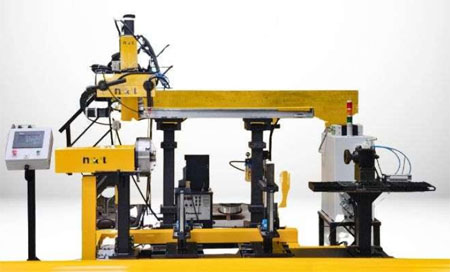Cylinder Welder
Vishes Global serves as a comprehensive provider of cutting-edge technology tailored for different industries, offering solutions for cleaning, passivation and corrosion challenges across various grades of stainless steel and high-performance alloys.
We are an authorized channel partner of Nikit Engineers on a PAN India level. By providing, best quality services and contemporary assistance to our esteemed customers, we aspire to create a special place for ourselves in the industry.
Circular Welders

A welding professional or welding apparatus specialized in welding cylindrical objects such as pipes, tanks or tubes, is commonly referred to as a Cylinder Welder. This welding process involves joining seams on cylindrical structures composed of diverse materials like metal, plastic or composite materials.
These apparatus play a crucial role in welding applications, particularly when dealing with cylindrical objects. The procedure for employing these devices entails several steps. Prior to welding, it is imperative to prepare the surfaces to be welded by cleaning them to eliminate any dirt, rust, or contaminants that may impede the welding process.
Additionally, the ends of the cylinders may require shaping or chamfering to ensure proper weld penetration. Secure positioning of the cylinders is essential, either horizontally or vertically, based on welding requirements and the design of the welding apparatus. To facilitate this, these tools often incorporate clamping mechanisms to firmly hold the cylinders in place throughout the welding process, ensuring alignment and stability, which are vital for achieving high-quality welds. Once the cylinders are securely positioned and clamped, the welding process commences. The operator manipulates the
welding equipment, which may include a welding machine, welding torch, and filler material, to apply heat and filler material along the seam of the cylinders, thereby creating a durable, continuous weld.
Throughout the welding process, the operator closely monitors parameters such as temperature, welding speed and the appearance of the weld bead to ensure compliance with required specifications and quality standards. Adjustments to welding parameters may be necessary to attain the desired results. Upon completion of welding, the welded cylinders are allowed to cool gradually to prevent metal warping or distortion. This cooling process is conducted slowly to minimize stress on the weld joint. Subsequently the welded cylinders undergo visual inspection and, in some instances, non-destructive
testing to verify weld integrity, checking for defects such as cracks, porosity, or incomplete fusion.
Features of Cylinder Welder:
• Power Source: These tools are available in different power sources such as electric arc, gas or laser, chosen based on specific welding requirements and materials.
• Welding Processes: They can perform various welding processes including arc welding, MIG (Metal Inert Gas) welding, TIG (Tungsten Inert Gas) welding and oxy-acetylene welding, each offering distinct advantages in terms of speed, precision and material compatibility.
• Controls and Settings: Modern welding apparatus are equipped with advanced control systems and settings, enabling operators to adjust parameters like voltage, current, wire feed speed and gas flow rate for precise control over the welding process and high-quality welds.
Benefits of Cylinder Welder:
• Increased Productivity: Welding apparatus facilitate fast and efficient joining of
metal components, enhancing productivity in manufacturing and fabrication
processes.
• High-Quality Welds: Precise control and versatility of welding apparatus result in
high-quality welds with minimal defects, ensuring welded joint integrity and
strength.
• Versatility: These tools can weld a wide range of metals and alloys, including steel,
aluminum, stainless steel and titanium, making them suitable for diverse industries
such as automotive, aerospace, construction and manufacturing.
• Cost Savings: By automating welding processes and minimizing material wastage,
welding apparatus contribute to overall production cost reduction.
• Improved Safety: Incorporation of safety features in welding apparatus safeguards
operators from hazards like electric shock, arc flash and welding fumes, fostering a
safer work environment and reducing workplace accidents.
• Consistency and Reproducibility: Welding apparatus ensure consistent weld
quality and reproducibility, enabling manufacturers to maintain uniformity across
products and meet stringent quality standards.
Cylinder Welder Applications industries:
• Manufacturing: Utilized for fabricating cylindrical components such as tanks,
vessels, pipes and cylinders for storage, transportation and processing purposes.
• Oil and Gas: Crucial for welding storage tanks, pipelines and pressure vessels
essential in exploration, extraction, refining and transportation within the oil and
gas industry.
• Automotive: Employed in manufacturing automotive components like fuel tanks,
hydraulic cylinders, exhaust systems and air compressors.
• Aerospace and Defense: Utilized for fabricating components such as fuel tanks,
hydraulic systems, rocket casings and pressure vessels in aerospace and defense
industries.
• Chemical and Petrochemical: Essential for welding storage tanks, reactors,
distillation columns and pipelines in chemical and petrochemical industries.
• Construction: Utilized in fabricating structures including water towers, silos,
pipelines and pressure vessels in the construction industry.
• Energy and Power Generation: Used for fabricating components like boilers, heat
exchangers, steam turbines and storage tanks in energy and power generation
sectors.
• Medical and Pharmaceutical: Employed in manufacturing medical gas cylinders,
storage tanks and process equipment for medical and pharmaceutical applications.
• Food and Beverage: Utilized for fabricating storage tanks, fermentation vessels
and processing equipment in the food and beverage industry.
• Marine and Shipbuilding: Utilized in fabricating components such as fuel tanks,
ballast tanks, pressure vessels and piping systems in marine and shipbuilding
industries.

